2000 AUDI ALLROAD air condition
[x] Cancel search: air conditionPage 5 of 306
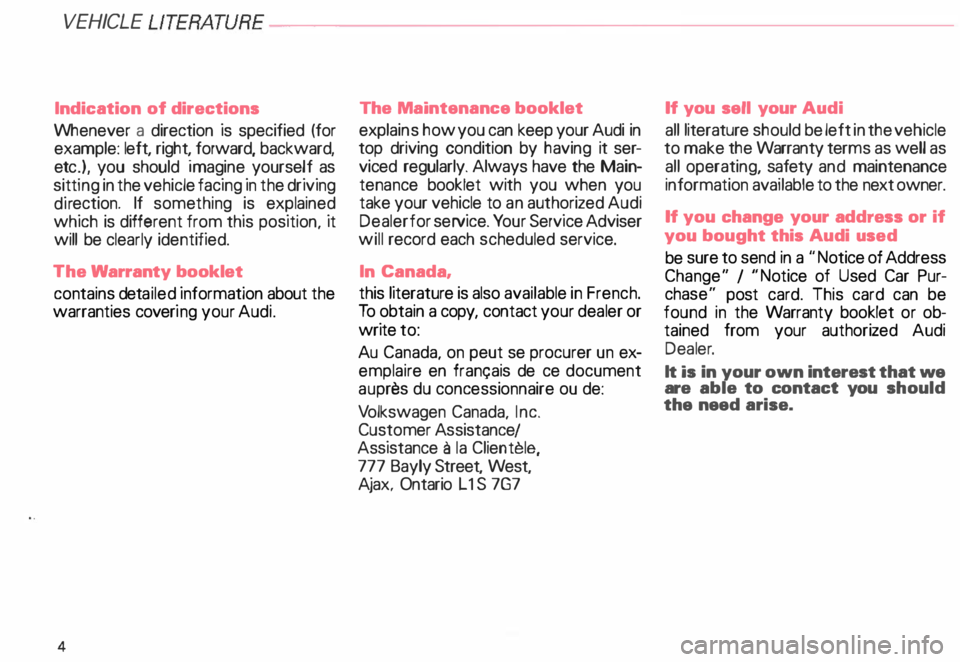
VEHIC
LE LIT
ERA TURE--------------
Indication of directions
Whenever a direction is specified (for
example: left, right, forward, backward,
etc. ), you should imagine yourself as
sitting in the vehicle facing in the driving
dir ection. If something is explained
which is different from this position, it
will be clearly identified.
The Warranty booklet
contains detailed information about the
warranties covering your Audi.
4 The
Maintenance booklet
explains how you can keep your Audi in
top driving condition by having it ser
viced regularly. Always have the Main
tenance booklet with you when you
take your vehicle to an authorized Audi
Dealer for service. Your Service Adviser
will record each scheduled service.
In Canada,
this literature is also available in French.
To obtain a copy, contact your dealer or
write to:
Au Canada, on peut se procurer un ex
emplaire en franc;:ais de ce document
aup res du concessionnaire ou de:
Vo lkswagen Canada, Inc.
Customer Assistance/
Assistance a Ia Clientele,
777 Bayly Street. West.
Aj ax. Ontario L 1 S 7G7 If
you sell your Audi
all literature should be left in the vehicle
to make the Warranty terms as well as
all operating, safety and maintenance
information available to the next owner.
If you change your address or if
you bought this Audi used
be sure to send in a "Notice of Address
Change" I "Notice of Used Car Pur
chase" post card. This card can be
found in the Warranty booklet or ob
tained from your authorized Audi
Dealer .
It is in your own interest that we
are able to contact you should
the need arise.
Page 7 of 306

TABLE OF CO
NTENTS----------------------------------------------
Cigar ette lighter I Socket ....... 181
Storage compartments
Steering wheel with
Audio controls .......••.... 0
Steering wheel with
radio and telephone equipment
in the steering wheel .
Mobile telephones and
CB radios ..
earphone ..•
Roof rack ... ..
I VEHICLE
OPERATION
The first 1,000 miles (1 500 km)-182
18 5
186
189 19 0
191
and afterwa rds ....... ....... .. 193
Operate your vehicle safely . . . . . 194
Operate your vehicle economically
and minimize pollution . . 195
Driving on rough roads or
rugged terrain . . . . . . . . . . 199
Braking . . . . . . . . . . . . . . . . . 201
Ele ctronic differential lock
(EDL) 204
6 Electronic
Stability Program
(ESP) .. .. .. .. .. .. .. .. .. 205
Driving with your quattro® . . . . . . 207
Trailer towing . . . . . . . . _ ... _ . . 208
I VEHICLE
CARE
Cleaning and protection 212
Fuel tank . . . . . . . .
222
Fuel supply . _ .... .. _ . . . . . . . . . . 225
Maintenance ..• •. .
Engine hood .
. . .
Engine compartment
Engine oil ..... ..... .
Engine cooling system
o •• •••
Power steering
Brake fluid ..
Battery ...
Air cleaner
Spark plugs
Belts . . . . .
. __ ..• .. ...
Windshield I
headlight washer container ..... 228
231
232
234
238
241
242
244 248
249
249
250 Wiper
blades
lires I Wheels
Difficult operating
conditions ...... . .
Additional accessories, Modifications and
Parts replacement ...... . .
I DO-IT-YOURSELF
SERVICE
First aid kit ....•.
Emergency
warning triangle . . . . . . . . .
Jack and tools ... .• . _ .. ..• .. ..
Spare wheel .. .. . .. ... . ..
Changing a wheel . . . • . . . . .
Fuses ........ .. . . . .. .. _ .. ..
Replacing bulbs
Installing I
replacing a radio
Emergency starting
Emergency towing with
commercial tow truck
Lifting vehicle .... . 251
252
262
262
263
263
264
266
267 274
277
277
278
281
283
Page 26 of 306

---------------------------------------------------SAFETY RRST
Airbag system
Your vehicle has two front and four
side airbags, one front and one side air
bag for each front seat occupant, one side
airbag" for each rear seat occupant sitting
on the left and right rear seat.
In addition, your vehicle is equipped with
head airbags* on the left and right sides to
protect occupants seated next to the front
and rear doors. System
components
The airbag system consists of the following:
• electronic control module,
• an inflatable airbag with gas generator in
side the steering wheel,
• an inflatable airbag with gas generator in
side the instrument panel tor the front pas
senger,
• supplemental side airbags in the back
rest padding of the front and rear seats*,
• an inflatable curtain head airbag above
the doors on each side,
• an AIRB AG indicator light in the
instrument cluster ( see "Warning I Indica
tor lights" page 125).
The indicator light in the instrument cluster
(readiness light) will light up for a few sec
onds each time the ignition is switched on.
The light monitors the electronic control
module, sensor circuits, and system wiring. The
system must be inspected
if the indicator light:
• does not come on when the ignition is
switched on,
• does not go out after a few seconds after
the ignition is switched on, or
• comes on while driving.
In the event of a system malfunction, the in
dicator light will stay on continuously to
serve as a constant reminder to have the
system repaired.
�W ARNING
If any of these conditions occur,
have the alrbag system inspected
immediately by your Audi Dealer.
Otherwise, the airbags in your ve
hicle may not work properly in
case of a frontal collision or a side
impact.
25
Page 29 of 306
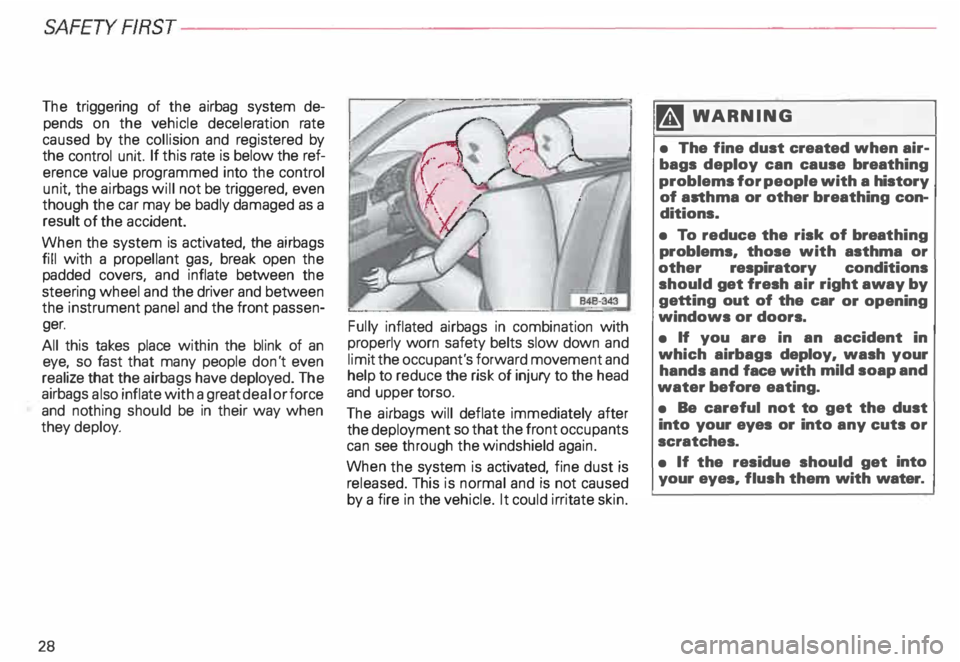
SAFETYRRST---------------------------------------------------
The triggering of the airbag system de
pends on the vehicle deceleration rate
caused by the collision and registered by
the control unit. If this rate is below the ref
erence value programmed into the control
unit, the airbags will not be triggered, even
though the car may be badly damaged as a
result of the accident.
When the system is activated, the airbags
fill with a propellant gas, break open the
padded covers, and inflate between the
steering wheel and the driver and between
the instrument panel and the front passen
ger.
All this takes place within the blink of an
eye, so fast that many people don't even
realize that the airbags have deployed. The
airbags also inflate with a great deal or force
and nothing should be in their way when
they deploy.
28 Fully
inflated airbags in combination with
properly worn safety belts slow down and
limit the occupant's forward movement and
help to reduce the risk of injury to the head
and upper torso.
The airbags will deflate immediately after
the deployment so that the front occupants
can see through the windshield again.
When the system is activated, fine dust is
released. This is normal and is not caused
by a fire in the vehicle. It could irritate skin. �W
ARNING
• The fine dust created when air
bags deploy can cause breathing
problems for people with a history
of asthma or other breathing con
ditions.
• To reduce the risk of brea thing
problems, those with asthma or
other respiratory conditions
should get fresh air right away by
getting out of the car or opening
windows or doors.
• If you are in an accident in
which airbags deploy, wash your
hands and face with mild soap and
water before eating.
• Be careful not to get the dust
into your eyes or into any cuts or
scratches.
• If the residue should get into
your eyes, flush them with water.
Page 36 of 306
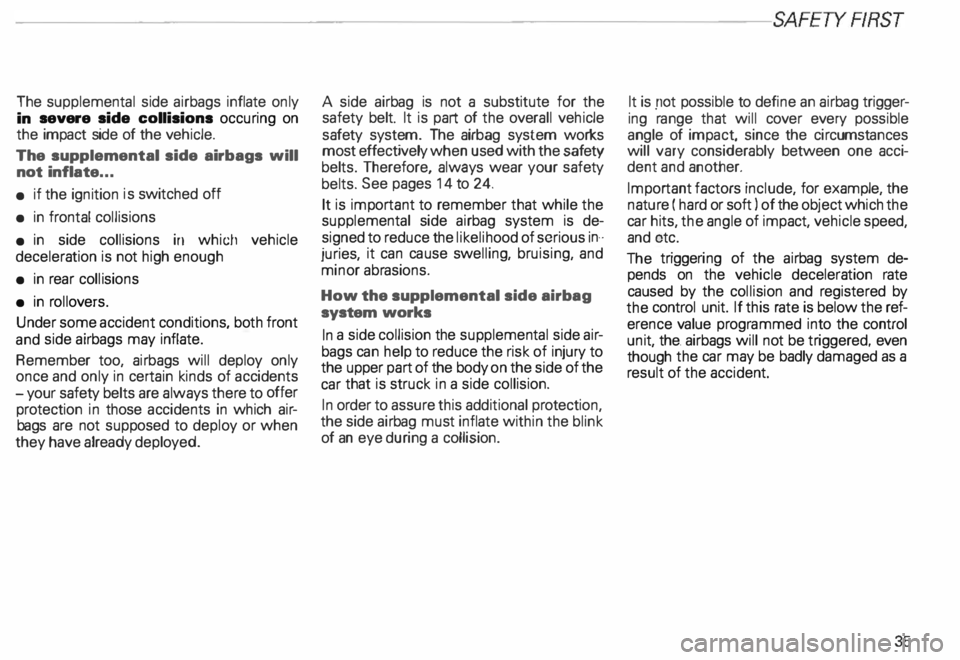
-----------------------------------------------------SAFETYRRST
The supplemental side airbags inflate only
in severe side collisions occuring on
the impact side of the vehicle.
The supplemental side airbags will
not inflate ...
• if the ignition is switched off
• in frontal collisions
• in side collisions in which vehicle
deceleration is not high enough
• in rear collisions
• in rollovers.
Under some accident conditions, both front
and side airbags may inflate.
Remember too, airbags will deploy only
once and only in certain kinds of accidents
- your safety belts are always there to offer
protection in those accidents in which air
bags are not supposed to deploy or when
they have already deployed. A
side airbag is not a substitute for the
safety belt. It is part of the overall vehicle
safety system. The airbag system works
most effectively when used with the safety
belts. Therefore, always wear your safety
belts. See pages 14 to 24.
It is important to remember that while the
supplemental side airbag system is de
signed to reduce the likelihood of serious in·
juries, it can cause swelling, bruising, and
minor abrasions.
How the supplemental side airbag
system works
In a side collision the supplemental side air
bags can help to reduce the risk of injury to
the upper part of the body on the side of the
car that is struck in a side collision.
In order to assure this additional protection,
the side airbag must inflate within the blink
of an eye during a collision. It
is )'lOt possible to define an airbag trigger
ing range that will cover every possible
angle of impact, since the circumstances
will vary considerably between one acci
dent and another.
Important factors include, for example, the
nature ( hard or soft ) of the object which the
car hits, the angle of impact, vehicle speed,
and etc.
The triggering of the airbag system de
pends on the vehicle deceleration rate
caused by the collision and registered by
the control unit. If this rate is below the ref
erence value programmed into the control
unit, the. airbags will not be triggered, even
though the car may be badly damaged as a
result of the accident.
35
Page 37 of 306
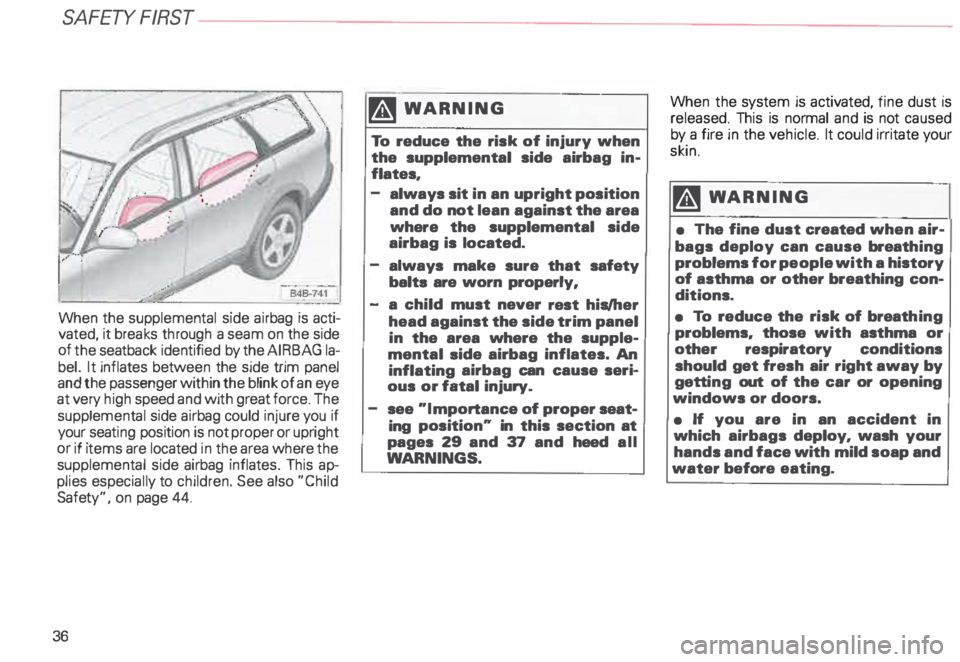
SA
FETY FIRST
When the supplemental side airbag is acti
vated, it breaks through a seam on the side
of the seatback identified by the AIR BAG la
bel. It inflates between the side trim panel
and the passenger within the blink of an eye
at very high speed and with great force. The
supplemental side airbag could injure you if
your seating position is not proper or upright
or if items are located in the area where the
supplemental side airbag inflates. This ap
plies especially to children. See also "Child
Safety". on page 44.
36 ----------------------------
�W ARNING
To reduce the risk of injury when
the supplemental side airbag in
flates.
always sit in an upright position
and do not lean against the area
where the supplemental side
airbag is located.
always make sure that safety
balta are worn properly,
- a child must never rest his/her
head against the side trim panel
in the area where the supple
mental aide airbag inflates. An
inflating airbag can cause seri
ous or fatal injury.
see "Importance of proper seat
ing position .. in this section at
pages 29 and 37 and heed all
WA RNINGS. When
the system is activated, fine dust is
released. This is normal and is not caused
by a fire in the vehicle. It could irritate your
skin.
�W ARNING
• The fine dust created when air
bags deploy can cause breathing
problems for people with a history
of asthma or other breathing con
ditions.
• To reduce the risk of breath ing
problems. those with asthma or
other respiratory conditions
should get fresh air right away by
getti ng out of the car or opening
windows or doors.
• If you are in an accident in
which airbags deploy. wash your
hands and face with mild soap and
water before eating.
Page 40 of 306
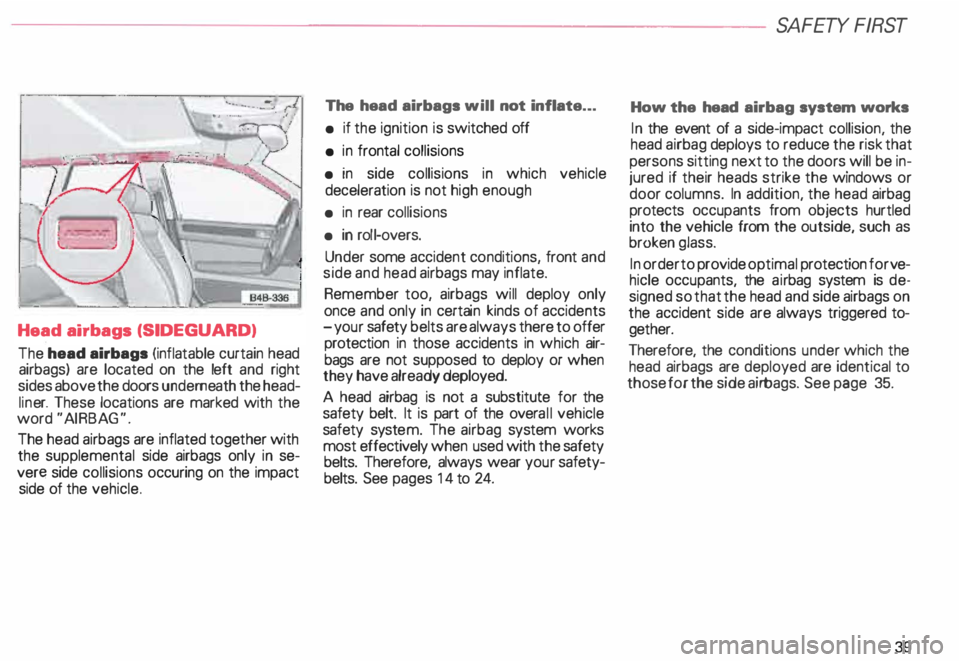
Head airbags (SIDEGUARD)
The head airbags (inflatable curtain head
airbags) are located on the left and right
sides above the doors underne ath the head
lin er. These locations are marked with the
word "AIRBAG".
The head airbags are inflated together with
the supplemental side airbags only in se
vere side collisions occuring on the impact
side of the vehicle. The
head airbags will not inflate ...
• if the ignition is switched off
• in frontal collisions
• in side collisions in which vehicle
deceleration is not high enough
• in rear collisions
• in roll-overs.
Under some accident conditions, front and
side and head airbags may inflate.
Remember too, airbags will deploy only
once and only in certain kinds of accidents
-y our safety belts are always there to offer
protection in those accidents in which air
bags are not supposed to deploy or when
they have already deployed.
A head airbag is not a substitute for the
safety belt It is part of the overa ll vehicle
safety system. The airbag system works
most effectively when used with the safety
belts. Therefore, always wear your safety
belts. See pages 14 to 24. SA
FETY FIRST
How the head airbag system works
In the event of a side-impact collision, the
head airbag deploys to reduce the risk that
persons sitting next to the doors will be in
jured if their heads strike the windows or
door columns. In addition, the head airbag
protects occupants from objects hurtled
into the vehicle from the outside, such as
broken glass.
In order to provide optimal protection for ve
hicle occupants, the airbag system is de
signed so that the head and side airbags on
the accident side are always triggered to
gether.
Therefore, the conditions under which the
head airbags are deployed are identical to
those for the side airbags. See page 35.
39
Page 41 of 306
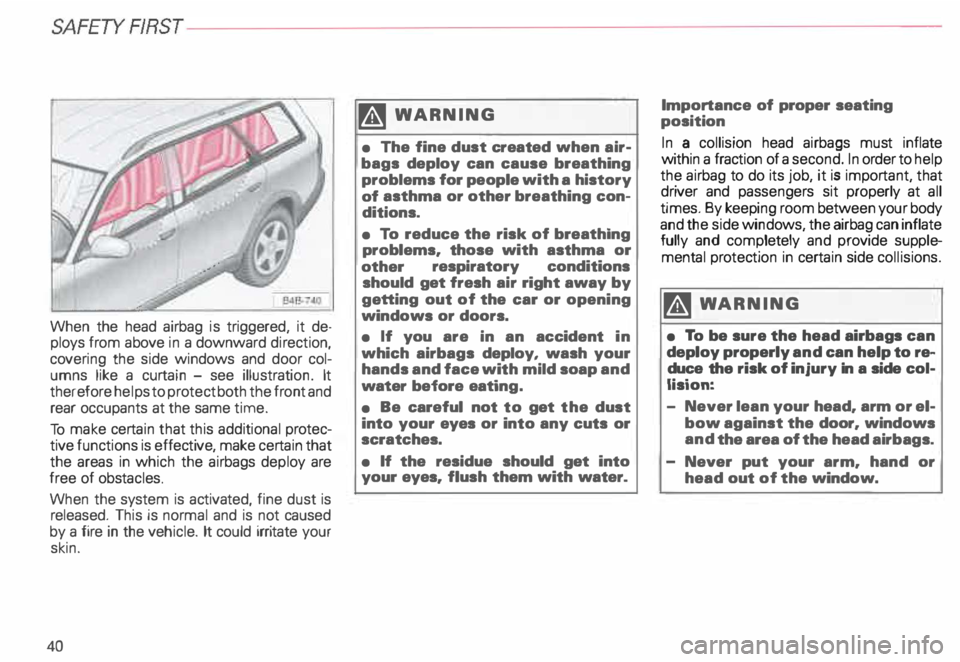
SAFETY RRST---------------------------------------------------
When the head airbag is triggered, it de
ploys from above in a downward direction,
covering the side windows and door col
umns like a curtain -see illustration. It
therefore helps to protect both the front and
rear occupants at the same time.
To make certain that this additional protec
tive functions is effective, make certain that
the areas in which the airbags deploy are
free of obstacles.
When the system is activated, fine dust is
released. This is normal and is not caused
by a fire in the vehicle. It could irritate your
skin.
40 �W
ARNING
• The fine dust created when air
bags deploy can cause breathing
problems for people with a history
of asthma or other breathing con
ditions.
• To reduce the risk of breathing
problems. those with asthma or
other respiratory
conditions
should get fresh air right away by
getting out of the car or opening
windows or doors.
• If you are in an accident in
which airbags deploy. wash your
hands and face with mild soap and
water before eating.
• Be careful not to get the dust
into your eyes or into any cuts or
scratches.
• If the residue should get into
your eyes. flush them with water. Importance
of proper seating
position
In a collision head airbags must inflate
within a fraction of a second. In order to help
the airbag to do its job, it is important, that
driver and passengers sit properly at all
times. By keeping room between your body
and the side windows, the airbag can inflate
fully and completely and provide supple
mental protection in certain side collisions.
�W ARNING
• To be sure the head airbags can
deploy properly and can help to re
duce the risk of injury In a side col
lision:
- Never lean your head. arm or el
bow against the door. windows
and the area of the head airbags.
Never put your arm. hand or
head out of the window.